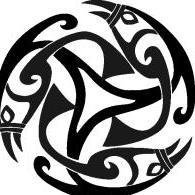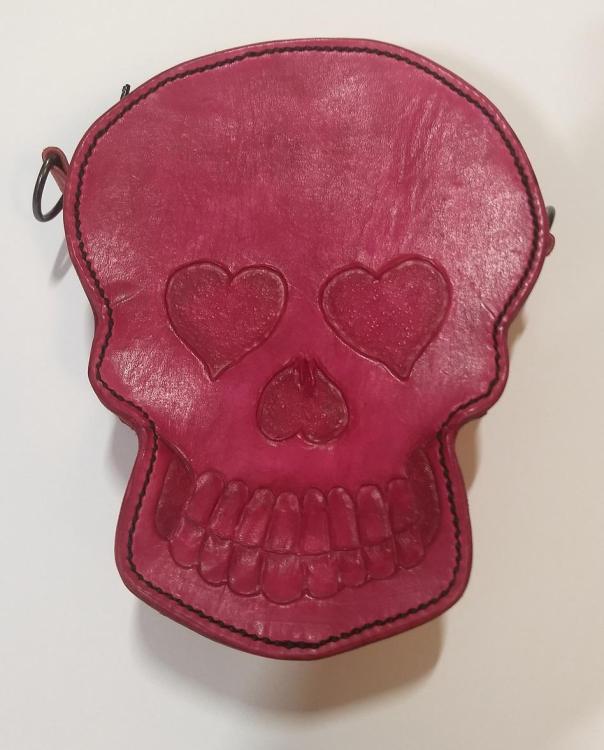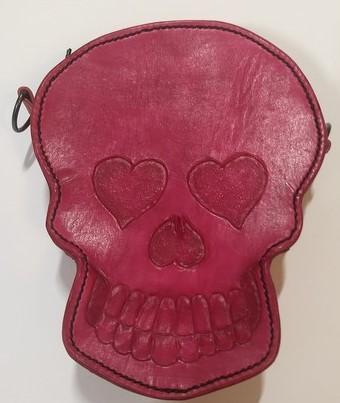-
Posts
1,091 -
Joined
-
Last visited
Content Type
Profiles
Forums
Events
Blogs
Gallery
Everything posted by DJole
-
That's a really nice piece, Stewart!
-
And as an appreciation gift, I made the customer a custom card wallet. The colors (dye and thread) and stamping pattern match the holster and belt. The color doesn't really fade from top to bottom -- that's just a photographic artifact. The purply-red leather is just a striking bit of on-sale remnant I had. It certainly makes a nice color pop! That's Fiebing's Antique Black Gel for the wallet, and the thread is Maine Thread .035 polyester cord, Golden Brown color. Stitching on the inside flat edge is 3mm, the perimeter is 5mm. The customer paid for the 3 and 5 hole bar grounder set (from Japan), so it was appropriate to use them in the tooling!
-
It's nearly done! The last thing we need to do is a final belt fitting to make SURE the buckle billet is long enough! (The 1st test fitting showed us that the customer didn't get the belt size quite right -- a couple inches off.) I finished the holster today. I'll upload belt pictures after I finish that up. Today I also sewed on the second set of cartridge loops, as the customer requested. Thanks, Fred! I've spent a while learning how to get it right, and I think I'm getting the hang of it now.
-

Vibrant Pink Color
DJole replied to TomG's topic in Dyes, Antiques, Stains, Glues, Waxes, Finishes and Conditioners.
-

Vibrant Pink Color
DJole replied to TomG's topic in Dyes, Antiques, Stains, Glues, Waxes, Finishes and Conditioners.
No, I used it straight, onto vegtan leather. -

Vibrant Pink Color
DJole replied to TomG's topic in Dyes, Antiques, Stains, Glues, Waxes, Finishes and Conditioners.
-
I find it useful to think of my hand as a "spring" when beveling a line. My fingers are holding the beveler lightly, just touching the line and the leather surface. The mallet strike pushes the beveler down, but my fingers "spring" the beveler back up. It's not a big movement, but enough to make the sliding easier. It also creates less fatigue in the fingers.
-
You could also cut a groove in the side walls, so that the bottom piece will "lock" into the groove in addition to friction fit.
-

Burnishing with black (or brown) tokonole vs. clear
DJole replied to yober's topic in How Do I Do That?
In my own limited experience, I do the same as you state above, with all three Tokonole types. But I don't think the color makes a difference. Can you post a picture of what you consider a mess? -
I'm doing a series of bags, and this is the newest one. Threads used: Ritza Silver, Ritza Chestnut (on the hanger loops), Maine Thread Cocoa (on the zipper), Maine Thread Scarlet (on the pocket) Dyes: Red and Black alcohol pens, Tandy EcoFlo Silver Frost, Tokonole Brown
-
Well, I don't know about that -- nothing I've ever got from my area IKEA store has had those problems. Certainly not the cutting boards! ;-)
-
Have you looked at Dark Horse Workshop (website and YouTube videos) for patterns and how-to instruction?
-
That is gorgeous work-- both the sheath and the knife. How is that striking yellow handle made?
-
I'm working on this Green Man face for a bag. I've got a handle on the floral tooling (oak leaves), but I'm not sure how to best do the face, especially the nose (and by extension, the eyes). I'm not sure what tools I should use, or what sequence of techniques, to get it right. Any of you figure modeling experts got some advice?
-
I recently acquired a nice set of 5 mm stitching irons, and of course they needed a case. I dipped into my scraps, and pulled out my cheap fluorescent colored thread (clearance at Tandy's!), and quickly whipped one up. The back is 3-4 mm veg tan, front and strap are 2mm chrome. That ought to keep the irons organized and safe!
-
Oof...that's very nice work! A great design and excellent tooling. She'd better love it. ;-)
-
Inkscape is a free program that I have downloaded and installed, to help build vector-based patterns. Again, there is a learning curve involved, of course...
-

Is there a reasonably priced leather supplier recommendation
DJole replied to Mulligan31's topic in Suppliers
Use the cheap leather for learning on. Practice the things you want to do later on -- stitching, tooling, dyeing, etc. Give away (or scrap bin) the projects that didn't quite work. You should know also that many leather suppliers will sell you a piece of leather cut to a certain size, and even skive it to a certain thickness for you. So if you need a 12 X 12 inch piece of 4 oz. leather, for example, it's much more affordable to get a luxury leather panel in that size than to buy a whole hide. -

Is there a reasonably priced leather supplier recommendation
DJole replied to Mulligan31's topic in Suppliers
In addition to your location, if you give us more information on what you are doing with this leather, and what kind of leather you are looking for, we can help a lot better!



















